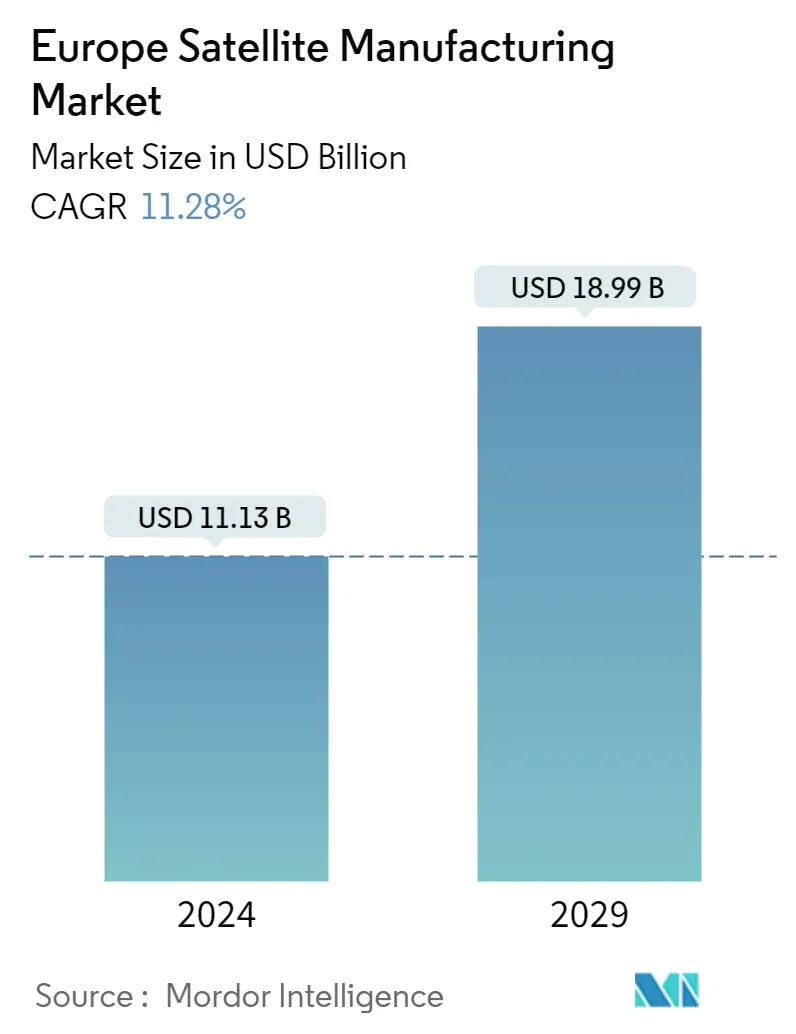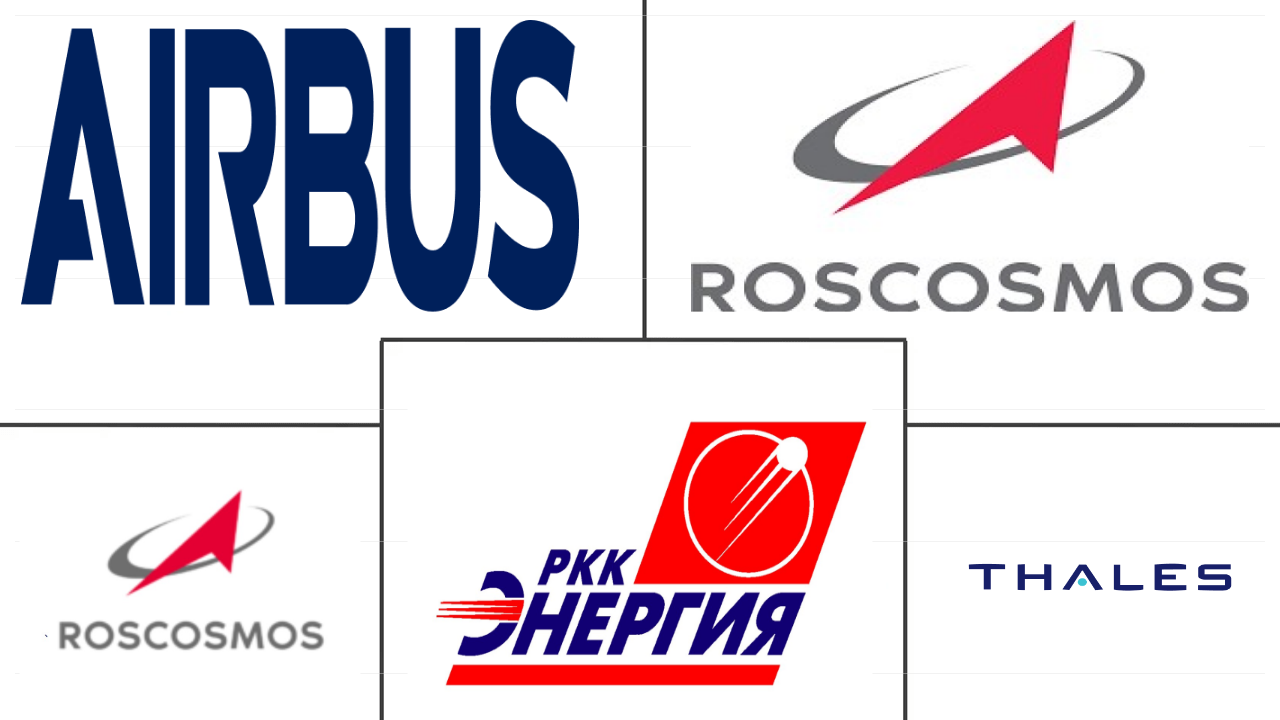Market Size of europe satellite manufacturing Industry

|
|
Study Period | 2017 - 2029 |
|
|
Market Size (2024) | USD 11.13 Billion |
|
|
Market Size (2029) | USD 18.99 Billion |
|
|
Largest Share by Orbit Class | LEO |
|
|
CAGR (2024 - 2029) | 11.28 % |
|
|
Largest Share by Country | Russia |
Major Players |
||

|
||
|
*Disclaimer: Major Players sorted in no particular order |
Europe Satellite Manufacturing Market Analysis
The Europe Satellite Manufacturing Market size is estimated at USD 11.13 billion in 2024, and is expected to reach USD 18.99 billion by 2029, growing at a CAGR of 11.28% during the forecast period (2024-2029).
11.13 Billion
Market Size in 2024 (USD)
18.99 Billion
Market Size in 2029 (USD)
4.13 %
CAGR (2017-2023)
11.28 %
CAGR (2024-2029)
Largest Market by Satellite Mass
57.78 %
value share, above 1000kg, 2022
Large satellites have a higher demand owing to their applications, such as satellite radio, communications, remote sensing, planetary security, and weather forecasting.
Largest Market by Application
54.75 %
value share, Earth Observation, 2022
Earth observation satellites are used for weather forecasting, forestry mapping, and pollution monitoring. The growing adoption of VAS by private companies and organizations is expected to fuel the growth of satellite-based Earth observation.
Largest Market by Orbit Class
77.80 %
value share, LEO, 2022
LEO satellites are increasingly being adopted in modern communication technologies as they play an important role in Earth observation applications.
Largest Market by Propulsion Tech
73.93 %
value share, Liquid Fuel, 2022
Because of its high efficiency, controllability, reliability, and long lifespan, liquid fuel-based propulsion technology is becoming an ideal choice for space missions. It can be used in various orbit classes for satellites.
Leading Market Player
64.89 %
market share, Airbus SE, 2022

Airbus is the leading player in the European satellite manufacturing market, with a robust distribution channel. Airbus has six major manufacturing sites in the region that help consolidate its market share.
LEO satellites are driving demand in the Europe satellite manufacturing market
- At launch, a satellite or spacecraft is usually placed in one of several special orbits around Earth, or it can be launched during an interplanetary voyage. There are three types of Earth orbits: Geostationary Orbit (GEO), Medium Earth Orbit, and Low Earth Orbit. Many weather and communications satellites tend to have high Earth orbits farthest from the surface. Medium Earth orbit satellites include navigational and specialized satellites designed to monitor a specific area. Most science satellites, including those, are in low Earth orbit.
- Different satellites manufactured and launched in this region have different applications. For instance, during 2017-2022, out of the 16 satellites manufactured and launched in the MEO orbit, most were built for navigation/global positioning purposes. Similarly, out of the 14 satellites in the GEO orbit, most were deployed for communication and earth observation purposes. Around 500+ LEO satellites manufactured and launched were owned by European organizations.
- The increasing use of satellites in areas such as electronic intelligence, earth science/meteorology, laser imaging, electronic intelligence, optical imaging, and meteorology is expected to drive the European satellite manufacturing market during the forecast period. The market is expected to surge by 91% during the forecast period (2023 and 2029).
High demand for communication satellites across the major countries in Europe is expected to propel the market
- Satellite telecommunications is by far the most important space industry for the European satellite manufacturing market, accounting for more than 60% of the satellite business in Europe. The sustainability and continuity of the European space industry determine the healthy position of the global satellite telecommunications industry.
- The European market has managed to maintain a share of around 40% in the space industry. However, technical and commercial pressure from US manufacturers and the new space powers is forcing European industry to maintain high competence and innovation. France, Germany, the United Kingdom, and Russia are among the leading countries in the development and launch of satellites in the European region.
- In addition to the relatively mature market for broadcast and fixed satellite services, other satellite communications services are growing rapidly. Around 60% of the revenue of the European space industry (EUR 5 billion) comes from the construction and launch of communication satellites, amounting to more than USD 8.8 billion or about EUR 6.85 billion. Revenue generated by Mobile Satellite Systems exceeds EUR 1,500 million.
- Due to many governmental, commercial, and other regional players, demand for the satellite manufacturing industry witnessed positive growth. During 2017-2022, more than 570 satellites were launched in the area. Of the more than 570 satellites produced and launched, nearly 90% were for commercial use. Between 2023 and 2029, the European market is expected to surge by 90% during the forecast period.
Europe Satellite Manufacturing Industry Segmentation
Communication, Earth Observation, Navigation, Space Observation, Others are covered as segments by Application. 10-100kg, 100-500kg, 500-1000kg, Below 10 Kg, above 1000kg are covered as segments by Satellite Mass. GEO, LEO, MEO are covered as segments by Orbit Class. Commercial, Military & Government are covered as segments by End User. Propulsion Hardware and Propellant, Satellite Bus & Subsystems, Solar Array & Power Hardware, Structures, Harness & Mechanisms are covered as segments by Satellite Subsystem. Electric, Gas based, Liquid Fuel are covered as segments by Propulsion Tech. France, Germany, Russia, United Kingdom are covered as segments by Country.
- At launch, a satellite or spacecraft is usually placed in one of several special orbits around Earth, or it can be launched during an interplanetary voyage. There are three types of Earth orbits: Geostationary Orbit (GEO), Medium Earth Orbit, and Low Earth Orbit. Many weather and communications satellites tend to have high Earth orbits farthest from the surface. Medium Earth orbit satellites include navigational and specialized satellites designed to monitor a specific area. Most science satellites, including those, are in low Earth orbit.
- Different satellites manufactured and launched in this region have different applications. For instance, during 2017-2022, out of the 16 satellites manufactured and launched in the MEO orbit, most were built for navigation/global positioning purposes. Similarly, out of the 14 satellites in the GEO orbit, most were deployed for communication and earth observation purposes. Around 500+ LEO satellites manufactured and launched were owned by European organizations.
- The increasing use of satellites in areas such as electronic intelligence, earth science/meteorology, laser imaging, electronic intelligence, optical imaging, and meteorology is expected to drive the European satellite manufacturing market during the forecast period. The market is expected to surge by 91% during the forecast period (2023 and 2029).
| Application | |
| Communication | |
| Earth Observation | |
| Navigation | |
| Space Observation | |
| Others |
| Satellite Mass | |
| 10-100kg | |
| 100-500kg | |
| 500-1000kg | |
| Below 10 Kg | |
| above 1000kg |
| Orbit Class | |
| GEO | |
| LEO | |
| MEO |
| End User | |
| Commercial | |
| Military & Government | |
| Other |
| Satellite Subsystem | |
| Propulsion Hardware and Propellant | |
| Satellite Bus & Subsystems | |
| Solar Array & Power Hardware | |
| Structures, Harness & Mechanisms |
| Propulsion Tech | |
| Electric | |
| Gas based | |
| Liquid Fuel |
| Country | |
| France | |
| Germany | |
| Russia | |
| United Kingdom |
Europe Satellite Manufacturing Market Size Summary
The European satellite manufacturing market is poised for significant growth, driven by the increasing demand for satellites across various applications such as electronic intelligence, earth science, and telecommunications. The market's expansion is supported by the robust presence of satellite telecommunications, which constitutes a major portion of the industry in Europe. The region maintains a substantial share in the global space industry, although it faces competitive pressures from US manufacturers and emerging space powers. Key countries like France, Germany, the United Kingdom, and Russia are at the forefront of satellite development and launch activities, contributing to the region's strong market position. The market is characterized by a mix of mature broadcast services and rapidly growing satellite communication services, with a notable focus on the construction and launch of communication satellites.
The demand for satellite manufacturing in Europe is further bolstered by advancements in satellite technology, including the development of miniature and microsatellites, which offer cost-effective solutions and sophisticated mission capabilities. The market is witnessing increased investments in startups and projects focused on nano and microsatellite development, enhancing the region's revenue potential. European countries are actively investing in space-related activities to maintain competitiveness, with significant funding allocated to earth observation, satellite navigation, and space research. The market is fairly consolidated, with major players like Airbus SE, Information Satellite Systems Reshetnev, ROSCOSMOS, RSC Energia, and Thales dominating the landscape. These companies are leveraging innovative technologies and strategic partnerships to drive growth and capitalize on emerging opportunities in the satellite manufacturing sector.
Europe Satellite Manufacturing Market Size - Table of Contents
-
1. MARKET SEGMENTATION (includes market size in Value in USD, Forecasts up to 2029 and analysis of growth prospects)
-
1.1 Application
-
1.1.1 Communication
-
1.1.2 Earth Observation
-
1.1.3 Navigation
-
1.1.4 Space Observation
-
1.1.5 Others
-
-
1.2 Satellite Mass
-
1.2.1 10-100kg
-
1.2.2 100-500kg
-
1.2.3 500-1000kg
-
1.2.4 Below 10 Kg
-
1.2.5 above 1000kg
-
-
1.3 Orbit Class
-
1.3.1 GEO
-
1.3.2 LEO
-
1.3.3 MEO
-
-
1.4 End User
-
1.4.1 Commercial
-
1.4.2 Military & Government
-
1.4.3 Other
-
-
1.5 Satellite Subsystem
-
1.5.1 Propulsion Hardware and Propellant
-
1.5.2 Satellite Bus & Subsystems
-
1.5.3 Solar Array & Power Hardware
-
1.5.4 Structures, Harness & Mechanisms
-
-
1.6 Propulsion Tech
-
1.6.1 Electric
-
1.6.2 Gas based
-
1.6.3 Liquid Fuel
-
-
1.7 Country
-
1.7.1 France
-
1.7.2 Germany
-
1.7.3 Russia
-
1.7.4 United Kingdom
-
-
Europe Satellite Manufacturing Market Size FAQs
How big is the Europe Satellite Manufacturing Market?
The Europe Satellite Manufacturing Market size is expected to reach USD 11.13 billion in 2024 and grow at a CAGR of 11.28% to reach USD 18.99 billion by 2029.
What is the current Europe Satellite Manufacturing Market size?
In 2024, the Europe Satellite Manufacturing Market size is expected to reach USD 11.13 billion.

